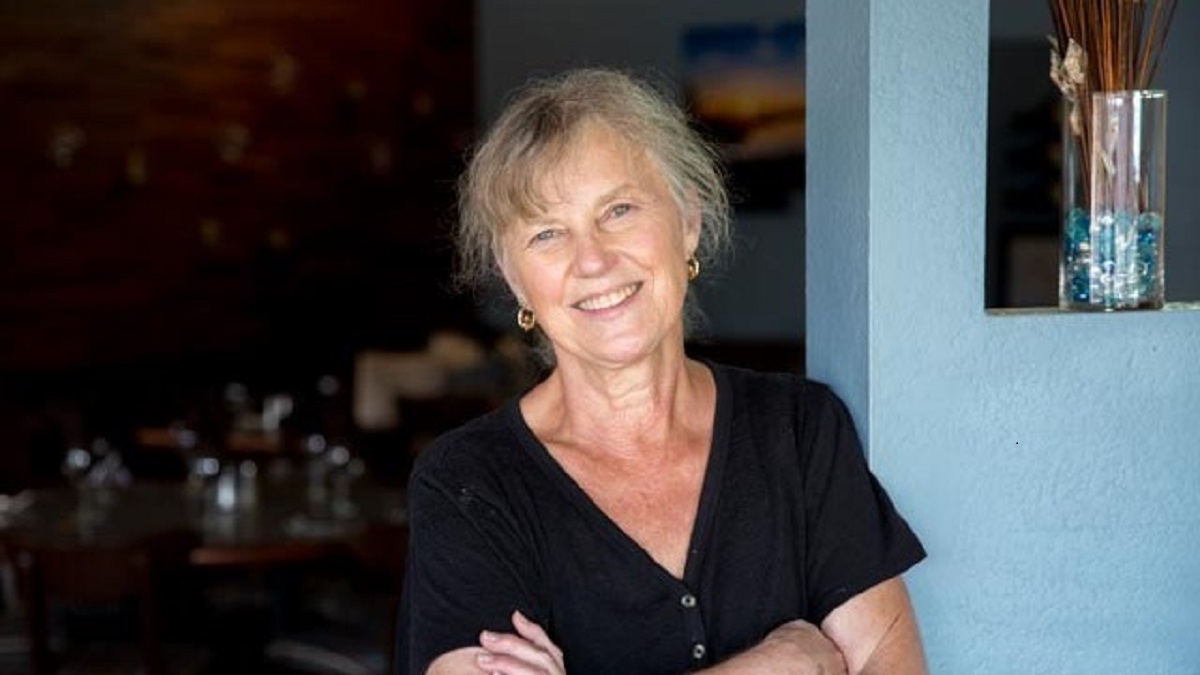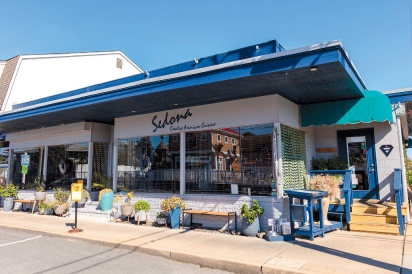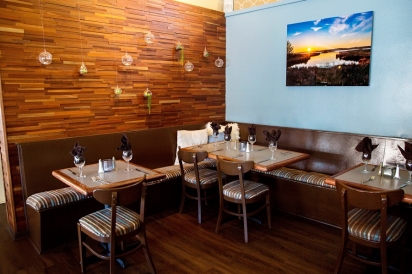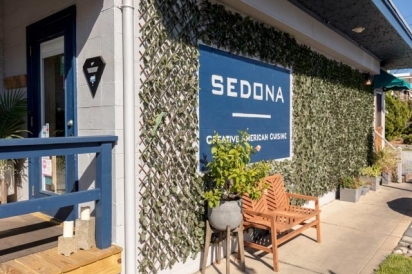Marian Parrott: Behind Sedona’s Success
It was a frigid day in January 1993, and Jonathan Spivak had just purchased Dante’s Pizza in Bethany Beach, Delaware. The Washington, D.C., marketing pro and consultant had taken a risk. “I had no restaurant experience, never worked in one and never owned one,” he says. “I found myself with keys to a dirty old pizza place, where I was going to create my Southwestern dream.”
That day, he was one of a few diners at Shark’s Cove in Fenwick Island, where Marian Parrott was his server. They began chatting, and halfway through the meal, he asked her to join his new endeavor. “She said, ‘What are you nuts?’” he recalls. He left his phone number, and two weeks later, she took the job.
Parrott never left. She is now the proprietress of Sedona, which is still Delmarva’s go-to spot for fine dining. The restaurant veteran is as much a part of Bethany’s fabric as her restaurant. But few customers would suspect that Parrott has a colorful past.
Coming to America
Parrott, 67, was born in Frankfurt, Germany, and placed in a Lutheran orphanage when she was 3 days old. The nuns were “rough but kind,” recalls Parrott, who gleefully jumped from bed to bed in a room full of them. For breakfast, she sipped coffee with cream and nibbled bread and butter.
The children wore clothes until they outgrew them, after which they passed them down. To this day, Parrott keeps garments until they “fall off her back,” she says. “It was all imprinted on me when I was very young.”
At age 7, Parrott was adopted by Joe Staley, an attorney for the U.S. State Department, and his wife. The couple returned to the United States aboard the SS Constitution. “My father brought me and a Mercedes back,” she says. “I’m not sure which he liked more.”
Parrott spoke no English, and her adopted parents spoke no German. Like most children, she adapted. “If you want a banana, you learn how to ask for it.” Today, she has a melodic voice with no discernible accent — the envy of any newscaster.
When Parrott was 9, her adopted mother died of a cerebral hemorrhage. Staley remarried, and it was not a happy household. As a result, Parrott skipped her last year at Arundel High School to study psychology at the University of Maryland in College Park.
A Sure Thing
The savvy survivor learned at an early age how to make a living in the restaurant industry. She was 12 when she became a busgirl at the Crofton Country Club. “I liked the atmosphere — people going out, having fun, having drinks and eating good food,” she says.
Like many college students, she worked in beach restaurants in the summer. After graduation, she moonlighted as a cocktail waitress in a Bethesda disco, where servers could upcharge the drinks and keep the difference.
A full-time gig as a commercial paper broker in Washington, D.C., was lucrative but unsatisfying. “Say goodbye to the money and do something else,” she told herself. The outdoor lover then worked summers in the Grand Canyon National Park in Arizona and winters in Salt Lake City, where bars were in private clubs. “I always went back to hospitality because it was easy to get a job,” she says. “It was quick money — all cash in those days.”
Fleeing a bad relationship, she joined a friend in Ocean City, Maryland, where she reconnected with George Parrott, her neighbor from those college summers at the beach. “When I went to Europe for a year, he came over to visit,” she recalls. “When we got back, we decided to get married.”
Sedona’s Start
A chef, George Parrott worked at Shark’s Cove. (He would later open the Garden Gourmet with John McDonald.) The couple had two young daughters, and Marian took a waitress job at the Fenwick establishment. The kitchen was in the basement, and servers lugged heavy trays upstairs. “The dumbwaiter was me,” she quips. When she met Spivak, she was tired of the steps and the commute to Fenwick Island. Sedona was closer to the family’s home.
Sedona’s concept was also appealing. Spivak was inspired by Mark Miller’s Red Sage in Washington, D.C., the sister restaurant of Coyote Café in Santa Fe, New Mexico. Southwestern cuisine was on the rise, and in 1992, Esquire magazine named Red Sage the country’s best restaurant.
“People loved the wild game and the spices,” Parrott says. “Red Sage was killing it. Jonathan is very smart; he knows how to read a trend.” The D.C. crowd fighting for a Red Sage reservation would love Sedona.
Spivak hired the kitchen help; Parrot managed the front of the house. “She brought in an excellent staff — really good people,” he says. Sedona would need them. On opening day, the staff served 70 chefs from the Delmarva Chefs Association. Miller was the speaker. “I told Marian, ‘Look, either we’re going to hit a home run, or you’re going back to [Shark’s Cove], and I’ll go back to D.C. working with lawyers again,” Spivak says. They knocked it out of the park.
Riding the Wave
Sedona was “trendy, innovative — a frontrunner,” Parrott says. According to The News Journal: “The décor and cuisine are influenced by the Southwest, but this isn’t a place for gussied-up Tex-Mex. Everything from salsa to pasta is made on premises (owner Jonathan Spivak even painted the pictures himself).”
The restaurant found firm footing when Jeff Thiemann replaced the opening chef. News Journal restaurant critic Al Mascitti commented on Thiemann’s “tongue-tied gumbo,” spicy jerked chicken, artichoke hearts and arugula-flavored sour cream, beautifully layered between fried wontons. In 1996, Spivak and Thiemann opened Fusion in Rehoboth Beach.
By year six, the Southwestern cuisine — like blackened Cajun everything — had grown stale. Tired of customers mispronouncing jicama, Parrott told Spivak that people wanted fresh seafood and crab cakes. Sedona adapted, and one of the most enduring dishes is a tuna appetizer with Asian slaw and a soy reduction.
By 2008, food costs were high, and chefs demanded good salaries. Spivak, a native New Yorker, suggested turning Sedona into a deli. Parrott, who had shares in the restaurant, didn’t want to slice turkey. “I said, ‘Buy me out.’ He wouldn’t do it. So, I said, ‘I’ll buy you out.’ He said, ‘OK,’” she says. “I didn’t have enough money, so I didn’t know what I would do.”
She found a silent partner in Scott Lucas from Potomac, Maryland. Spivak, meanwhile, went on to open Salt Air in Fusion’s old digs.
Ups & Downs
It was not a good time to be a restaurateur. The housing bubble was about to burst. Fortunately, Sedona’s D.C.-centric base still had government contracts and money to spend. “But we saw a decline in business in 2010,” Parrott says. “It almost broke the bank. We survived that.”
Thanks to government grants, Sedona also got through the 2020 pandemic. However, Parrott made changes that stuck. For one, Sedona reduced the number of menu items. “It still covers a lot of bases,” she says. “It’s sophisticated but approachable.” When restaurant seating was limited, she found that guests liked having more space, so she reduced the number of seats.
In the last year, Parrott has seen many new faces among the old. Interacting with the owner is one reason why they all appreciate Sedona, she maintains. But there are others, according to a Facebook page for Bethany Beach residents. “It’s a small, intimate, welcoming restaurant,” wrote one fan. “The food is always delicious, and they have some great craft cocktails. I’m comfortable going there by myself if no one is around. Can’t say that for all restaurants.”
When Parrott is not baking Sedona’s desserts or negotiating with vendors, she likes to refinish furniture and garden. She also spends time with daughters Caitlyn and Kelsey. A chip off the entrepreneurial block, Caitlyn owns S.A.L.T. Provisions, which carries everything from apparel to self-care products to sriracha horseradish, and Pinch of S.A.L.T, which offers children’s items.
While Parrott has given 30 years to Sedona, she has not neglected herself. Some of her happiest moments have been outside the restaurant. Consider the time she stood on an 18,000-foot-high peak in Nepal and stared at the azure sky. “You could shoot me now,” she remembers thinking of achieving such a state of bliss.
Then there was the afternoon she spent with her two daughters in a sun-splashed café in Croatia. As a British musician sang in the square, they sipped Aperol spritzes. Parrott had it all: family, good food, great beverages and a cultured ambiance.
“It was,” she says, “perfect.”
Sedona
26 North Pennsylvania Ave, Bethany Beach, DE
(302) 539-1200
Facebook Instagram










